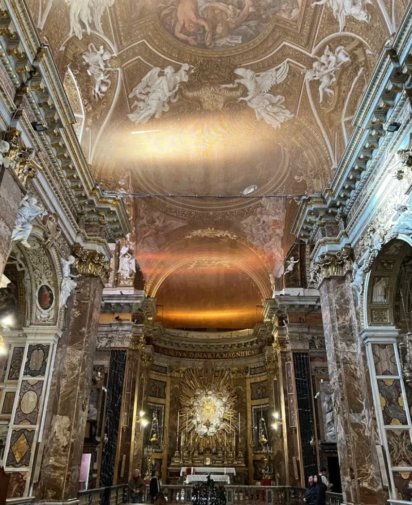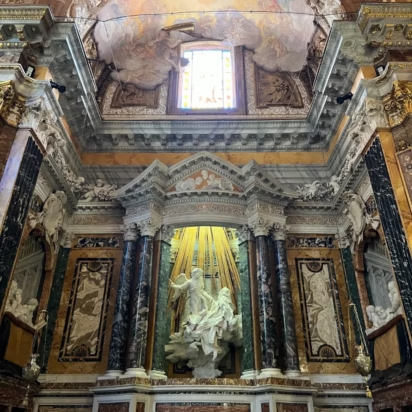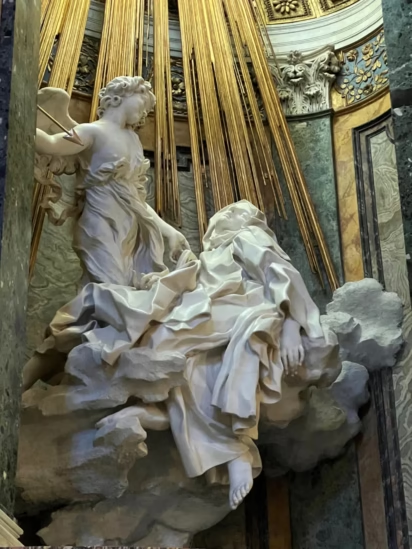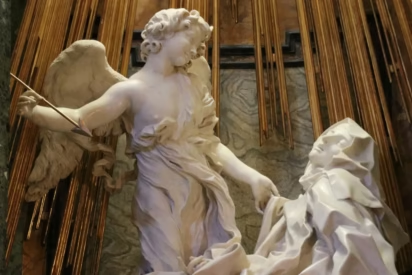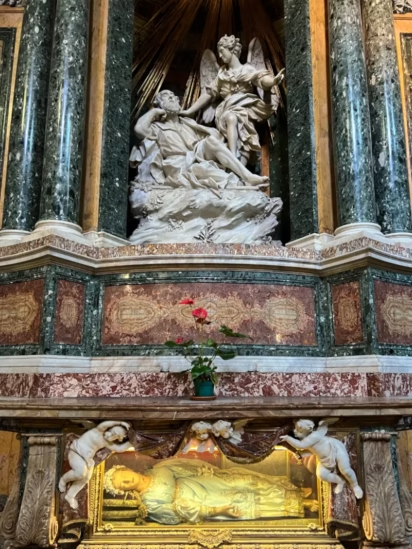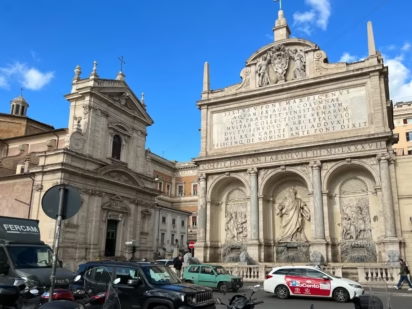Bernini’s daring Ecstasy of Saint Teresa in the Santa Maria della Vittoria Church in Rome is one of the best Baroque marble sculptures ever.

Bernini’s Ecstasy of Saint Teresa is the main reason to visit the otherwise unassuming small Baroque church of Santa Maria della Vittoria near Rome’s Termini station. This marble sculpture is a masterpiece of the High Roman Baroque and one of the best works Bernini ever created. Although showing religious ecstasy, it is borderline erotic despite hardly showing any naked flesh. As a bonus, visiting is absolutely free.
Santa Maria della Vittoria Church in Rome
The Santa Maria della Vittoria Church in Rome is a fairly small single, wide nave baroque church built by the Discalced Carmelites in the early 17th century. Cardinal Scipione Borghese financed the rather grand facade in exchange for the Borghese Hermaphroditus that was found when the foundations were dug. (The Borghese Hermaphroditus on the equally famous Bernini-carved marble mattress is now in the Louvre with only a lesser version in the Borghese Gallery in Rome.)
The church is named after a painting of the Virgin Mary that was carried before the Catholic League at the Battle of White Mountain in 1620, which reversed the Reformation in Bohemia. The altar painting is a copy of the original (destroyed in a church fire in 1833) and although the Turkish standard captured in the 1683 siege of Vienna is of historic interest, by far the largest number of visitors to the church some to see the Bernini masterpiece.
Bernini’s Ecstasy of Saint Teresa in Rome
The Ecstasy of Saint Teresa (also known as Saint Teresa in Ecstasy or the Transverberation of Saint Teresa; L’Estasi di Santa Teresa or Santa Teresa in estasi) is a sculptural group in white marble in the church of Santa Maria della Vittoria in Rome. This life-size sculpture of St Teresa and a Seraph by Gian Lorenzo Bernini was completed in 1647-52. It is in the Cornaro Chapel in the front of the church with further sculptures of the Cornaro family looking on as if in a theater.
The sculpture illustrates the encounter between the Discalced Carmelite nun Teresa of Avilla (1515-1582) and an angel as she described it in her autobiography (free at Project Gutenberg):
“I saw in his hand a long spear of gold, and at the iron’s point there seemed to be a little fire. He appeared to me to be thrusting it at times into my heart, and to pierce my very entrails; when he drew it out, he seemed to draw them out also, and to leave me all on fire with a great love of God. The pain was so great, that it made me moan; and yet so surpassing was the sweetness of this excessive pain, that I could not wish to be rid of it. The soul is satisfied now with nothing less than God. The pain is not bodily, but spiritual; though the body has its share in it. It is a caressing of love so sweet which now takes place between the soul and God, that I pray God of His goodness to make him experience it who may think that I am lying.”
Bernini’s Controversial Ecstasy of Saint Teresa in Rome
Bernini’s Ecstasy of Saint Teresa was certainly controversial throughout the centuries. It may be a masterpiece of the high Roman Baroque and for many the best work he had ever done but it was a risky interpretation of a popular pious saint of a strict order designed to be placed in a church and not the Villa Borghese Gallery where his Apollo could chase Daphne with clothes flying in the wind.
Although the sculpture shows hardly any bare flesh, it has been described as erotic. The jump from religious spiritual ecstasy to physical sexual orgasm is easily made even with Teresa almost fully clothed — her bare feet indicate legs spread, the serif unnecessarily pulls her habit open, she’s leaning back, and her mouth is open. As a French diplomat observed, “If this is divine love, I know it well…”
Franco Mormando summarized Bernini’s effort well:
“Far from rendering a literal depiction of Teresa’s narrative, Bernini, instead, threw caution to the wind and cast reality far aside in several glaring ways that simply have no counterpart in the historical record or previous renditions of the scene: not merely the most obvious details of Teresa’s impossibly juvenile chronological age and idealized, dainty features, but also the not-so-subtle suggestive disposition of her near-prostrate body and her unmistakably splayed-apart legs, and the silky sensuousness of her luxuriously voluminous dress, as well as her undress, that is, her conspicuously loosened wimple and, most especially, her two bare feet, one of them directly hitting the eye of the viewer, front and almost center.”
(This and the quote below from Did Bernini’s Ecstasy of St. Teresa Cross a 17th-century Line of Decorum? by Franco Mormando (2016) — an interesting and entertaining lecture absolutely worth reading, free pdf.)
The Seraph in Bernini’s Ecstasy of Saint Teresa
Only one written denunciation from Bernini’s time survived and that was an anonymous critic who denounced Bernini who “in forming his St. Teresa in the church of the Vittoria, dragged that most pure Virgin not only into the Third Heaven, but into the dirt, to make a Venus not only prostrate but prostituted….”
The seraph certainly doesn’t help. Not nude, but his naked breast is a reflection of Teresa’s still being covered. Furthermore, with a face and look as “innocent” as Caravaggio’s Cupid Victorious (now in the Gemäldegalerie in Berlin), many a visitor will see the young seraph as the god of love, Cupid (Eros / Amor), rather than an angel and messenger from a Christian heaven. Cupid and Venus often go together. (Cupid is the extramarital love-child of Venus and Mars in many interpretations; born from Chaos in many others but mostly a symbol of physical love.)
The composition of The Ecstasy of St Teresa might have been inspired by other paintings, especially of Cupid and Venis. Many see a direct influence by Corregio’s Danae, a work very familiar to Bernini. (It is still in the Borghese Gallery). Cupid holds Danaë’s dress while she seems in ecstasy being impregnated by golden rain falling from Zeus, who had transformed himself into a cloud.
More Art in Santa Maria della Vittoria Church in Rome
In the mid-17th century, the Santa Maria della Vittoria Church was on the outskirts of Rome away from the main pilgrim streams. Bernini’s sculpture almost certainly would have been less acceptable in a major church such as St Peter’s Basicila in the Vatican. Although it is now in the heart of Rome, not far from the main station, very few would visit the church if it was not for Bernini’s The Ecstasy of St Teresa.
The interior of Santa Maria della Vittoria is baroque with all surfaces covered but it is nothing special compared to so many other small churches in Rome. In any other location but directly opposite the Bernini, the sculpture The Dream of Joseph by Domenico Guidi would have been more appreciated. It is well made and took inspiration from the Bernini but the dream of an aging man and a female angel (despite fully exposed naked legs) simply can’t compete with a young virgin in ecstasy.
The paintings in the church are by artists such as Guercino, Domencichino, and Guido Reni — all very famous in their time but currently not very fashionable or considered particularly interesting. The relic of the Roman martyr Victoria (230-253) below the Joseph sculpture is unrelated to the name of the church.
The altar painting is a copy of the original of the Virgin Mary that was carried before the Roman Catholic League at the victory in 1620. The ceiling fresco in the apse shows the “holy painting” being carried into Prague after the battle. The main fresco in the vault of the nave depicts The Virgin Mary Triumphing over Heresy and Fall of the Rebel Angels by Giovanni Domenico Cerrini (1675).
Santa Maria della Vittoria Church in Rome Visitor’s Information
Santa Maria della Vittoria Church is open Monday to Saturday from 9:00 to noon and 15:30 to 18:00; Sundays from 15:30 to 18:00.
Admission is free but coins may be needed to feed the lights.
The church is at Via XX Settembre 17, a few blocks to the north of Termini Station and close to Repubblica metro station and the Baths of Diocletian. Across the street is an interesting fountain of Moses (Fontana dell’Acqua Felice) built in 1585-88. The central large statue of Moses by Leonardo Sormani has hair that reminds of the horns of Michelangelo’s Moses in the San Pietro in Vinculo church.
